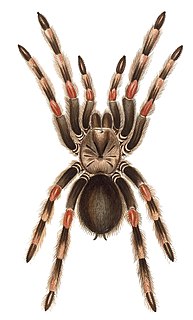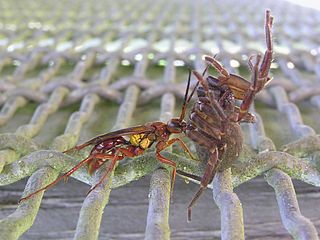
A tarantula hawk is a spider wasp (Pompilidae) that preys on tarantulas. Tarantula hawks belong to any of the many species in the genera Pepsis and Hemipepsis. They are one of the largest parasitoid wasps, using their sting to paralyze their prey before dragging it to a brood nest as living food; a single egg is laid on the prey, hatching to a larva which eats the still-living prey.

Wasps in the family Pompilidae are commonly called spider wasps, spider-hunting wasps, or pompilid wasps. The family is cosmopolitan, with some 5,000 species in six subfamilies. Nearly all species are solitary, and most capture and paralyze prey, though members of the subfamily Ceropalinae are kleptoparasites of other pompilids, or ectoparasitoids of living spiders.

Brachypelma smithi is a species of spider in the family Theraphosidae (tarantulas) native to Mexico. It has been confused with Brachypelma hamorii; both have been called Mexican redknee tarantulas. Mexican redknee tarantulas are a popular choice as pets among tarantula keepers. Many earlier sources referring to B. smithi either relate to B. hamorii or do not distinguish between the two species. B. smithi is a terrestrial tarantula native to Pacific coast of the Mexican state of Guerrero.

Pterinochilus murinus is an old-world tarantula that was first described in 1897 by Reginald Innes Pocock. This species is found on the African continent, in Angola, as well as central, eastern, and southern Africa. It is a member of the subfamily Harpactirinae, baboon spiders.

Porrhothele antipodiana, the black tunnelweb spider, is a spider found throughout much of New Zealand and the Chatham Islands in bush and gardens and is one of New Zealand's most researched spiders. It is related to tarantulas, and is a harmless relative of the venomous Australian funnel-web spider.
Hysterocrates gigas is a member of the tarantula family, Theraphosidae found in Cameroon. It is known as the giant baboon spider, Cameroon red baboon spider, or red baboon tarantula.

The Texas brown tarantula, also known as Oklahoma brown tarantula or Missouri tarantula, is one of the most common species of tarantula living in the Southern United States today. Texas brown tarantulas can grow to leg spans in excess of 4 in (10 cm), and weigh more than 3 oz as adults. Their bodies are dark brown, though shades may vary between individual tarantulas. The colors are more distinct after a molt, as with many arthropods.

Episyron rufipes, the red-legged spider wasp, is a red and black or completely black spider-hunting wasp.

Cryptocheilus australis, the golden spider wasp, is an Australian pepsid spider wasp that was accidentally introduced to New Zealand around 1960.

Sphictostethus nitidus, the golden hunter wasp or red spider wasp, is a species of pepsid spider wasp endemic to New Zealand.
Agenioideus nigricornis, the redback spider-hunting wasp, is a species of spider wasp from the subfamily Pompilinae, found in Australia. It is a parasitoid of the venomous redback spider.

Cantuaria dendyi is a species of trapdoor spider in the family Idiopidae. It can be found in the South Island of New Zealand and is limited to the Christchurch and Banks Peninsula area.

Anoplius viaticus, commonly known as the black-banded spider wasp, is a species of spider wasp. These wasps are known as spider wasps because the females capture spiders to provide their offspring with food. The paralysed spider is cached in a burrow, the wasp lays an egg on it, and when this hatches, the developing wasp larva consumes the spider. This species is found in sandy heathland across most of Europe.
Augacephalus breyeri is a species of harpactirine theraphosid spider, found in South Africa, Mozambique and Swaziland.
Anoplius infuscatus is a species of spider wasp found mainly in Eurasia.

Pepsis grossa is a very large species of pepsine spider wasp from the southern part of North America, south to northern South America. It preys on tarantula spiders, giving rise to the name tarantula hawk for the wasps in the genus Pepsis and the related Hemipepsis. Only the females hunt, so only they are capable of delivering a sting, which is considered the second most painful of any insect sting; scoring 4.0 on the Schmidt sting pain index compared to the bullet ant's 4.0+. It is the state insect of New Mexico. The colour morphs are the xanthic orange-winged form and the melanic black winged form. In northern South America, a third form, known as "lygamorphic", has a dark base to the wings which have dark amber median patches and a pale tip.

Tetragnatha montana, commonly known as the silver stretch spider, is a species of long-jawed orb weaver from the family Tetragnathidae that has a Palearctic distribution. It preys mostly on flies and mosquitoes. The name silver stretch spider refers to its shiny metallic colour and its habit of extending its legs into a stick like shape.

Andrena bicolor, or Gwynne's mining bee, is a common and widespread Western Palearctic mining bee which is found over most of Europe as well as North Africa and the Middle East and which reaches eastwards into Siberia.

Cantuaria borealis is a native New Zealand species of trapdoor spider.

Campsomeriella thoracica, the orange scarab hunter wasp, is a species of scarab parasitoid wasp that has been recorded in the Middle East, Mediterranean, and Sub-Saharan Africa.


















